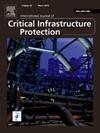Securing cyber-physical systems: Attack detection and isolation in power grid AGC
IF 5.3
3区 工程技术
Q1 COMPUTER SCIENCE, INFORMATION SYSTEMS
International Journal of Critical Infrastructure Protection
Pub Date : 2025-10-15
DOI:10.1016/j.ijcip.2025.100806
引用次数: 0
Abstract
Modern power systems integrate cutting-edge communication and computational technologies with the physical infrastructure, making them a good example of a cyber–physical system (CPS). Like any other CPS, the power system is prone to cyber attacks, particularly in automatic generation control (AGC). AGC in the power system relies on the communication network and is therefore vulnerable to attacks. This paper studies the detection and isolation of multiple simultaneous attacks against multi-area AGC in the presence of renewable energy resources (RERs) and electric vehicles (EVs). The impact of EVs and RERs is modeled as unknown inputs/disturbances. A directional unknown input observer (DUIO) based approach is proposed to assure simultaneous disturbance decoupling and attack isolation with lesser computational burden than the existing schemes. The effectiveness of the proposed method is validated through comprehensive case studies and simulations on a two-area interconnected AGC power system, representing a typical multi-region power grid with renewable energy and electric vehicle integration.
保护网络物理系统:电网AGC中的攻击检测和隔离
现代电力系统将尖端的通信和计算技术与物理基础设施相结合,使其成为网络物理系统(CPS)的一个很好的例子。与任何其他CPS一样,电力系统容易受到网络攻击,特别是在自动发电控制(AGC)中。电力系统中的AGC依赖于通信网络,因此容易受到攻击。本文研究了在可再生能源和电动汽车存在的情况下,针对多区域AGC的多重同时攻击的检测与隔离。ev和RERs的影响被建模为未知输入/干扰。提出了一种基于方向性未知输入观测器(directional unknown input observer, DUIO)的方法,在保证干扰解耦和攻击隔离的同时,减少了现有方法的计算量。通过典型的可再生能源与电动汽车融合多区域电网的两区互联AGC电力系统的综合案例研究和仿真,验证了所提方法的有效性。
本文章由计算机程序翻译,如有差异,请以英文原文为准。
求助全文
约1分钟内获得全文
求助全文
来源期刊

International Journal of Critical Infrastructure Protection
COMPUTER SCIENCE, INFORMATION SYSTEMS-ENGINEERING, MULTIDISCIPLINARY
CiteScore
8.90
自引率
5.60%
发文量
46
审稿时长
>12 weeks
期刊介绍:
The International Journal of Critical Infrastructure Protection (IJCIP) was launched in 2008, with the primary aim of publishing scholarly papers of the highest quality in all areas of critical infrastructure protection. Of particular interest are articles that weave science, technology, law and policy to craft sophisticated yet practical solutions for securing assets in the various critical infrastructure sectors. These critical infrastructure sectors include: information technology, telecommunications, energy, banking and finance, transportation systems, chemicals, critical manufacturing, agriculture and food, defense industrial base, public health and health care, national monuments and icons, drinking water and water treatment systems, commercial facilities, dams, emergency services, nuclear reactors, materials and waste, postal and shipping, and government facilities. Protecting and ensuring the continuity of operation of critical infrastructure assets are vital to national security, public health and safety, economic vitality, and societal wellbeing.
The scope of the journal includes, but is not limited to:
1. Analysis of security challenges that are unique or common to the various infrastructure sectors.
2. Identification of core security principles and techniques that can be applied to critical infrastructure protection.
3. Elucidation of the dependencies and interdependencies existing between infrastructure sectors and techniques for mitigating the devastating effects of cascading failures.
4. Creation of sophisticated, yet practical, solutions, for critical infrastructure protection that involve mathematical, scientific and engineering techniques, economic and social science methods, and/or legal and public policy constructs.
 求助内容:
求助内容: 应助结果提醒方式:
应助结果提醒方式:


